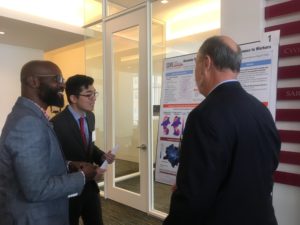UrbComp student Davon Woodard spends summer in Data Science for the Public Good program, using data to improve communities

Davon Woodard, far left, and undergrad Cory Kim discuss their DSPG team findings with sponsor Wayne Strickland.
Davon Woodard has spent the past few months in the National Capital Region as a fellow for Data Science for the Public Good (DSPG). The program, launched and directed by the Social and Decision Analytics Laboratory (SDAL) at the Biocomplexity Institute of Virginia Tech, engages young scholars in conducting research at the intersection of statistics, computation, and the social sciences to determine how information generated within the community can be leveraged to improve quality of life.
Woodard, a Ph.D. student in the planning, governance, and globalization program in the School of Public and International Affairs and a graduate research assistant at the Global Forum of Urban and Regional Resilience, is also a research trainee in the National Science Foundation-sponsored Urban Computing (UrbComp) Certificate program administered through the Discovery Analytics Center. The UrbComp program trains students in the latest methods in analyzing massive datasets to study key issues concerning urban populations.
“I was attracted to the DSPG program by the challenge and opportunity of solving real-world issues,” said Woodard. “In many programs, students work on projects that will get put on a shelf and never seen again but DSPG moves beyond data science ‘practice.’ I knew that the projects that I had with DSPG were effecting front line service delivery and public policy.”
Woodard was one of six graduate fellows — and the only one from Virginia Tech — chosen through a competitive process. The summer program began in May and culminated on August 9 at a DSPG symposium held at the Virginia Tech Research Center — Arlington where students presented their research to their sponsors.
Each of the 15 DSPG project teams consisted of SDAL faculty, a graduate student, and undergraduate students from the Honors College at Virginia Tech.
“An additional advantage for our graduate fellows is that they gain leadership experience by managing and mentoring the undergraduate students on their project teams,” said Gizem Korkmaz, research assistant professor, and co-lead of the DSPG program at SDAL.
For their sponsor Wayne Strickland, director of the Roanoke Valley and Alleghany Region (RVAR) Commission, Woodard’s team identified factors that contribute to the attractiveness of the RVAR region with the goal to recruit and retain people to the workforce — both within and outside of the region. Within the region, the Commission is interested in identifying those who
are not currently in the labor force (i.e. early retirees, recent graduates) by improving job supply and demand match; providing transportation options; and improving housing quality. Outside of the region, they are interested in attracting individual and families to the region to build their workforce and foster economic development.
During the research process, the team accessed GIS shapefiles, geocoded locations of businesses and transportation routes, used multiple sources of federal statistics combined with local data, and identified issues through data analysis.
“Using American Community Survey data, we modeled synthetic populations on county and sub-county levels in the region for variables related to workforce development, economic development, and housing affordability,” said Woodard, “and while considering what attracts people to stay or come to an area, we further expanded our research to include health related issues like food insecurity, primary care providers, and obesity, as well as natural assets like air quality and greenways.”
Woodard helped create a workforce development composite index of “Regional Attractiveness” by neighborhoods to support local initiatives for both external and internal job force engagement. Early findings show that singles and families with college degrees live closer to the city of Roanoke and its surrounding areas, while singles and families with a high school education are more dispersed throughout the county. Transportation options are limited to vehicles for most residents in the region, and many face long commutes to their jobs .
Woodard’s second project was working with the Community Sponsor Network in Arlington County on the issue of equity, which identifies the disadvantaged by unmet needs for resources and services.
The DSPG team coupled data from the 2006-2016 American Community Service Data Census Bureau and data from the Bureau of Labor Statistics to research and analyze issues of equity in housing in Arlington County vis-a-vis middle-class and low-income worker earnings and local industry growth.
Arlington County is interested in formulating policies that keep people in Arlington. They want residents to earn a sufficient wage to assume middle class standing and be able to afford housing, Woodard said.
Based on the general recommendation to spend no more than 30 percent of gross monthly income (before taxes) on housing, the research team considered eviction rates and access to transportation and healthy food as well as statistics relating to jobs, salaries, and housing costs to determine an affordable price range for people renting or buying in the area.
“I am very happy to have had the opportunity to be part of the DSPG program,” said Woodard. “The UrbComp program’s curriculum, collaborations, and partnerships prepared me well to work with sponsors on a day-to-day basis and to use real-world data sets to help them find solutions to their community problems.”